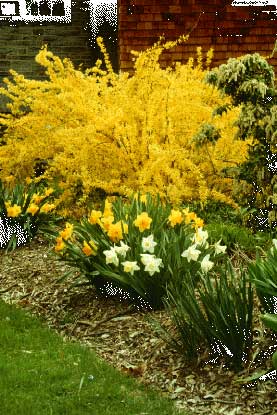 |
| © Bob Lollo |
Using Forsythia in the Yard
Because of their size and vigorous growth, most border forsythias are too unwieldy to include in a shrub border. They do better as individual specimen or accent plants. They need plenty of room to grow and spread. Their medium-green foliage blends well with other shrubs in a border background all summer. Use forsythias as screens or for slope cover. They can even be trained to grow as small standard trees 3 to 6 feet high. With severe pruning they can be shaped into a hedge, but they do not blossom abundantly because the buds are often pruned away when the hedge is sheared.
Forcing/Cutting For Display Indoors
Budded forsythia branches will bloom indoors as early as December. They are among the easiest and earliest of the flowering shrubs to force. However, the closer they are to their normal bloom time, the faster they will bloom prematurely indoors. Cut stems on a mild day. The more swollen the buds, the sooner they will open in the warmth of the house. To maintain a pleasing natural shape for the shrub, choose branches that the shrub will never miss. The longer the selected branches the more flowers there will be. Long stems are also more versatile for indoor arrangements.
Once indoors, cut off the ends of the branches for a fresh cut, slit the woody ends to help them absorb water, and immediately immerse them in warm water to soak for 3 to 4 hours. Strip off any leaves that will be underwater, then place them in a dimly lit, cool place until the buds begin showing color.
Change the water periodically. When you see some yellow in the buds, arrange the forsythia branches in a vase with fresh water. Add some commercial floral preservative or some citrus-based carbonated soda (non-diet) to the water to prolong their freshness when the flowers open. Bring them into a bright room where they can be appreciated. These blooms should last about a week and lift winter weary spirits.
If you choose to wait until they bloom outdoors to bring some in, cut the branches just as the buds are showing color. Put them in water as described above. Display them alone, or combined with spring bulb flowers such as early tulips, daffodils and other flowering shrubs such as quince and dogwood.

